Healthcare Surgical Safety Australia Report 2022
VerifiedAdded on 2022/10/08
|8
|2091
|15
AI Summary
Contribute Materials
Your contribution can guide someone’s learning journey. Share your
documents today.
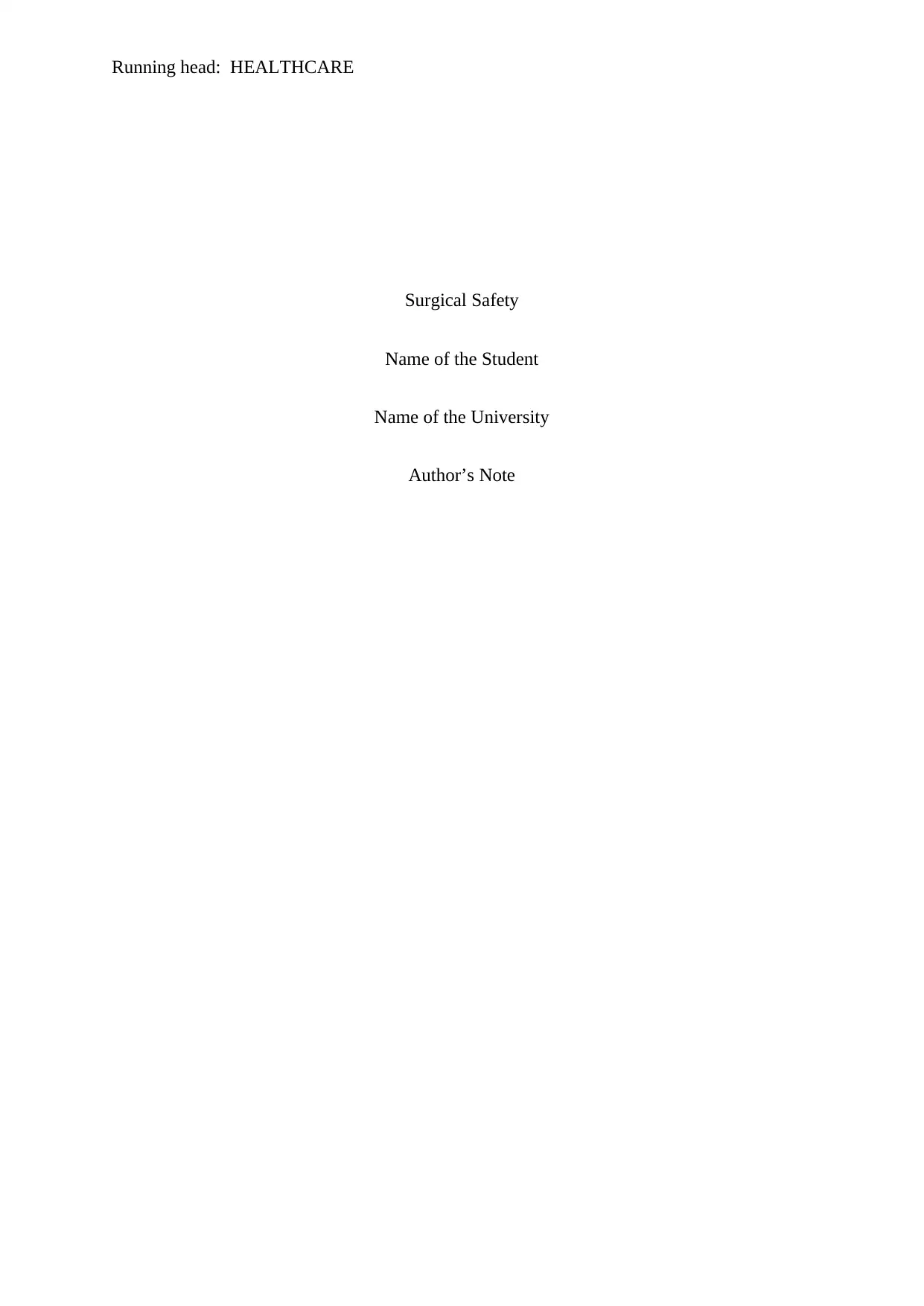
Running head: HEALTHCARE
Surgical Safety
Name of the Student
Name of the University
Author’s Note
Surgical Safety
Name of the Student
Name of the University
Author’s Note
Secure Best Marks with AI Grader
Need help grading? Try our AI Grader for instant feedback on your assignments.
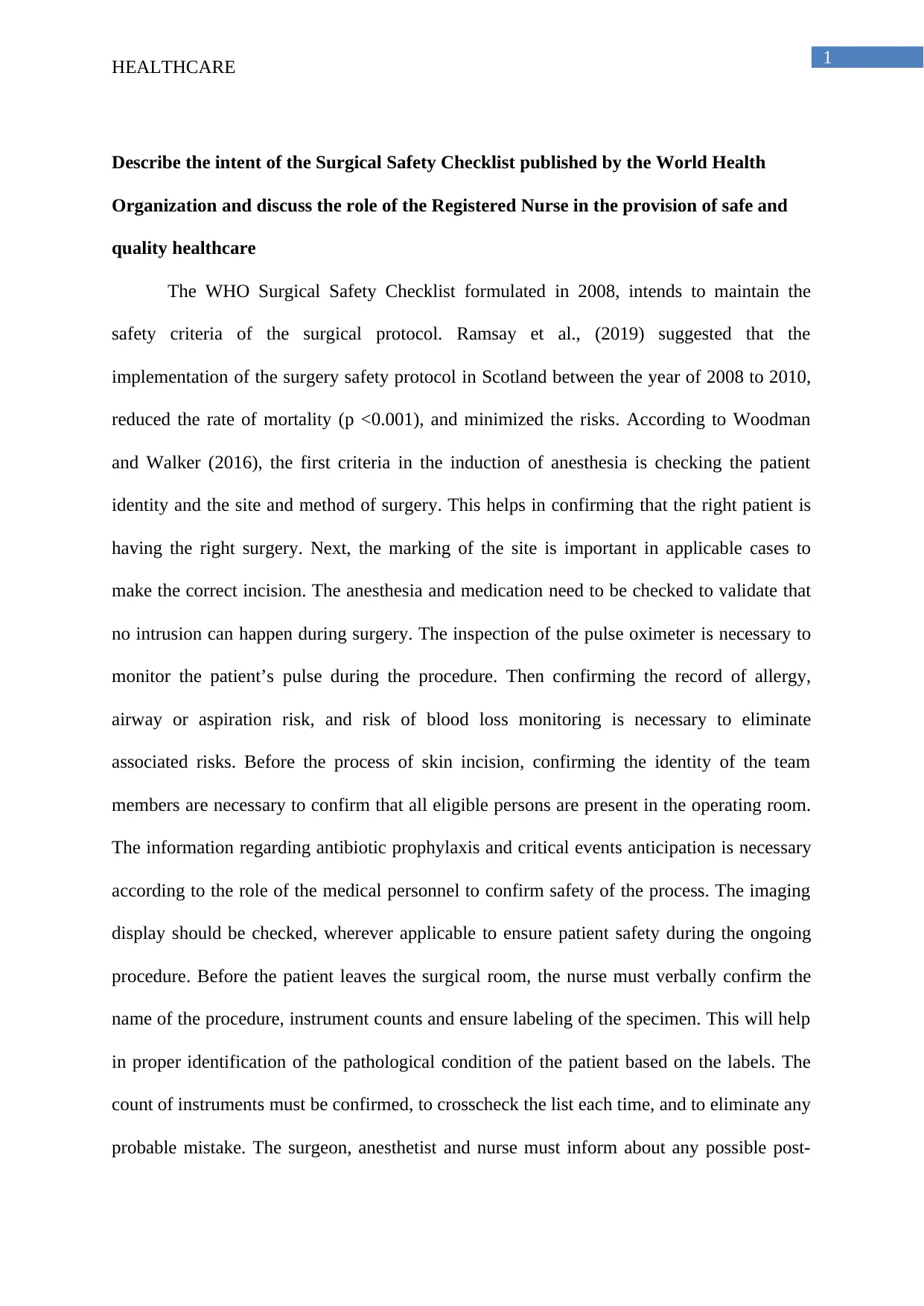
1
HEALTHCARE
Describe the intent of the Surgical Safety Checklist published by the World Health
Organization and discuss the role of the Registered Nurse in the provision of safe and
quality healthcare
The WHO Surgical Safety Checklist formulated in 2008, intends to maintain the
safety criteria of the surgical protocol. Ramsay et al., (2019) suggested that the
implementation of the surgery safety protocol in Scotland between the year of 2008 to 2010,
reduced the rate of mortality (p <0.001), and minimized the risks. According to Woodman
and Walker (2016), the first criteria in the induction of anesthesia is checking the patient
identity and the site and method of surgery. This helps in confirming that the right patient is
having the right surgery. Next, the marking of the site is important in applicable cases to
make the correct incision. The anesthesia and medication need to be checked to validate that
no intrusion can happen during surgery. The inspection of the pulse oximeter is necessary to
monitor the patient’s pulse during the procedure. Then confirming the record of allergy,
airway or aspiration risk, and risk of blood loss monitoring is necessary to eliminate
associated risks. Before the process of skin incision, confirming the identity of the team
members are necessary to confirm that all eligible persons are present in the operating room.
The information regarding antibiotic prophylaxis and critical events anticipation is necessary
according to the role of the medical personnel to confirm safety of the process. The imaging
display should be checked, wherever applicable to ensure patient safety during the ongoing
procedure. Before the patient leaves the surgical room, the nurse must verbally confirm the
name of the procedure, instrument counts and ensure labeling of the specimen. This will help
in proper identification of the pathological condition of the patient based on the labels. The
count of instruments must be confirmed, to crosscheck the list each time, and to eliminate any
probable mistake. The surgeon, anesthetist and nurse must inform about any possible post-
HEALTHCARE
Describe the intent of the Surgical Safety Checklist published by the World Health
Organization and discuss the role of the Registered Nurse in the provision of safe and
quality healthcare
The WHO Surgical Safety Checklist formulated in 2008, intends to maintain the
safety criteria of the surgical protocol. Ramsay et al., (2019) suggested that the
implementation of the surgery safety protocol in Scotland between the year of 2008 to 2010,
reduced the rate of mortality (p <0.001), and minimized the risks. According to Woodman
and Walker (2016), the first criteria in the induction of anesthesia is checking the patient
identity and the site and method of surgery. This helps in confirming that the right patient is
having the right surgery. Next, the marking of the site is important in applicable cases to
make the correct incision. The anesthesia and medication need to be checked to validate that
no intrusion can happen during surgery. The inspection of the pulse oximeter is necessary to
monitor the patient’s pulse during the procedure. Then confirming the record of allergy,
airway or aspiration risk, and risk of blood loss monitoring is necessary to eliminate
associated risks. Before the process of skin incision, confirming the identity of the team
members are necessary to confirm that all eligible persons are present in the operating room.
The information regarding antibiotic prophylaxis and critical events anticipation is necessary
according to the role of the medical personnel to confirm safety of the process. The imaging
display should be checked, wherever applicable to ensure patient safety during the ongoing
procedure. Before the patient leaves the surgical room, the nurse must verbally confirm the
name of the procedure, instrument counts and ensure labeling of the specimen. This will help
in proper identification of the pathological condition of the patient based on the labels. The
count of instruments must be confirmed, to crosscheck the list each time, and to eliminate any
probable mistake. The surgeon, anesthetist and nurse must inform about any possible post-
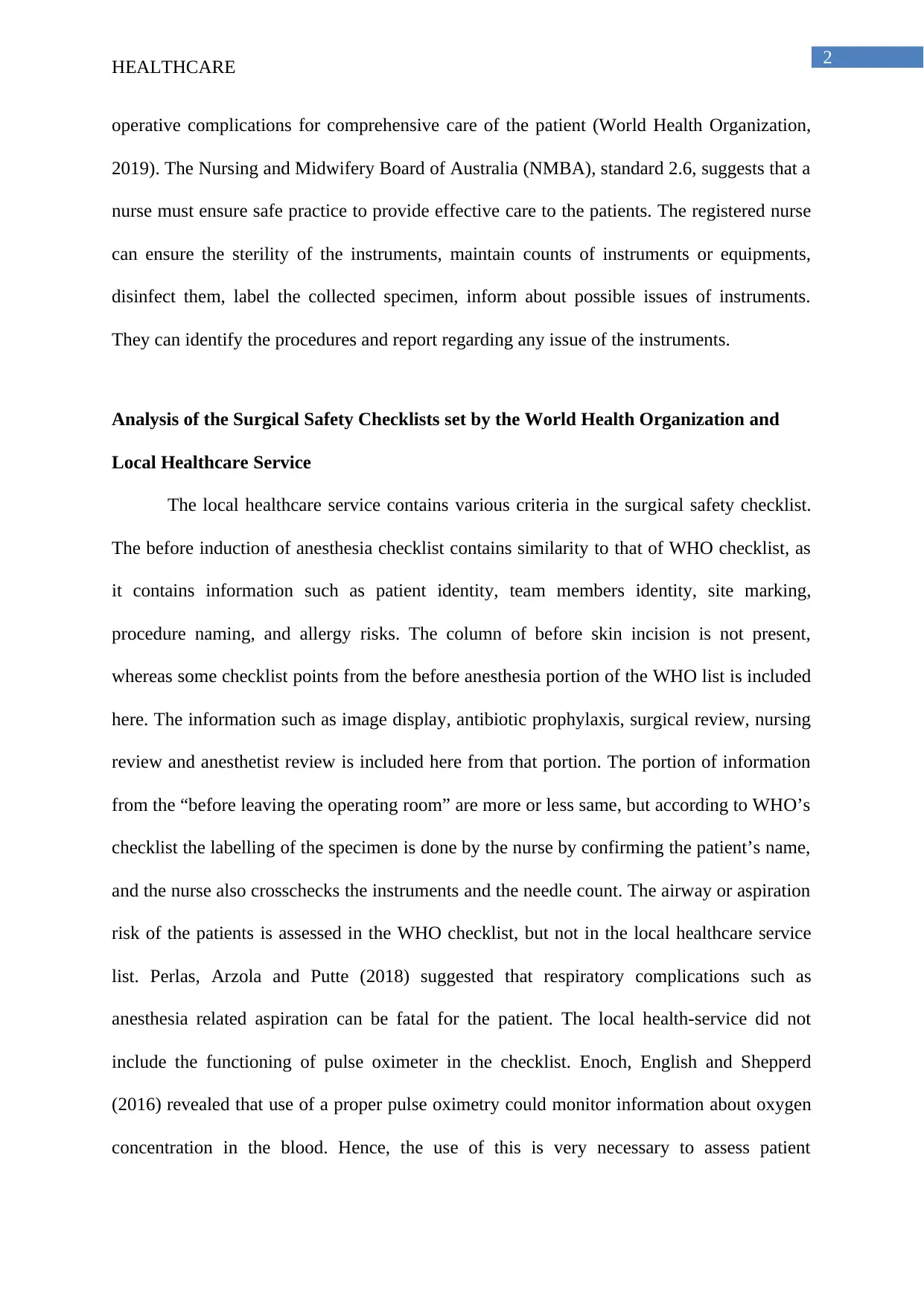
2
HEALTHCARE
operative complications for comprehensive care of the patient (World Health Organization,
2019). The Nursing and Midwifery Board of Australia (NMBA), standard 2.6, suggests that a
nurse must ensure safe practice to provide effective care to the patients. The registered nurse
can ensure the sterility of the instruments, maintain counts of instruments or equipments,
disinfect them, label the collected specimen, inform about possible issues of instruments.
They can identify the procedures and report regarding any issue of the instruments.
Analysis of the Surgical Safety Checklists set by the World Health Organization and
Local Healthcare Service
The local healthcare service contains various criteria in the surgical safety checklist.
The before induction of anesthesia checklist contains similarity to that of WHO checklist, as
it contains information such as patient identity, team members identity, site marking,
procedure naming, and allergy risks. The column of before skin incision is not present,
whereas some checklist points from the before anesthesia portion of the WHO list is included
here. The information such as image display, antibiotic prophylaxis, surgical review, nursing
review and anesthetist review is included here from that portion. The portion of information
from the “before leaving the operating room” are more or less same, but according to WHO’s
checklist the labelling of the specimen is done by the nurse by confirming the patient’s name,
and the nurse also crosschecks the instruments and the needle count. The airway or aspiration
risk of the patients is assessed in the WHO checklist, but not in the local healthcare service
list. Perlas, Arzola and Putte (2018) suggested that respiratory complications such as
anesthesia related aspiration can be fatal for the patient. The local health-service did not
include the functioning of pulse oximeter in the checklist. Enoch, English and Shepperd
(2016) revealed that use of a proper pulse oximetry could monitor information about oxygen
concentration in the blood. Hence, the use of this is very necessary to assess patient
HEALTHCARE
operative complications for comprehensive care of the patient (World Health Organization,
2019). The Nursing and Midwifery Board of Australia (NMBA), standard 2.6, suggests that a
nurse must ensure safe practice to provide effective care to the patients. The registered nurse
can ensure the sterility of the instruments, maintain counts of instruments or equipments,
disinfect them, label the collected specimen, inform about possible issues of instruments.
They can identify the procedures and report regarding any issue of the instruments.
Analysis of the Surgical Safety Checklists set by the World Health Organization and
Local Healthcare Service
The local healthcare service contains various criteria in the surgical safety checklist.
The before induction of anesthesia checklist contains similarity to that of WHO checklist, as
it contains information such as patient identity, team members identity, site marking,
procedure naming, and allergy risks. The column of before skin incision is not present,
whereas some checklist points from the before anesthesia portion of the WHO list is included
here. The information such as image display, antibiotic prophylaxis, surgical review, nursing
review and anesthetist review is included here from that portion. The portion of information
from the “before leaving the operating room” are more or less same, but according to WHO’s
checklist the labelling of the specimen is done by the nurse by confirming the patient’s name,
and the nurse also crosschecks the instruments and the needle count. The airway or aspiration
risk of the patients is assessed in the WHO checklist, but not in the local healthcare service
list. Perlas, Arzola and Putte (2018) suggested that respiratory complications such as
anesthesia related aspiration can be fatal for the patient. The local health-service did not
include the functioning of pulse oximeter in the checklist. Enoch, English and Shepperd
(2016) revealed that use of a proper pulse oximetry could monitor information about oxygen
concentration in the blood. Hence, the use of this is very necessary to assess patient
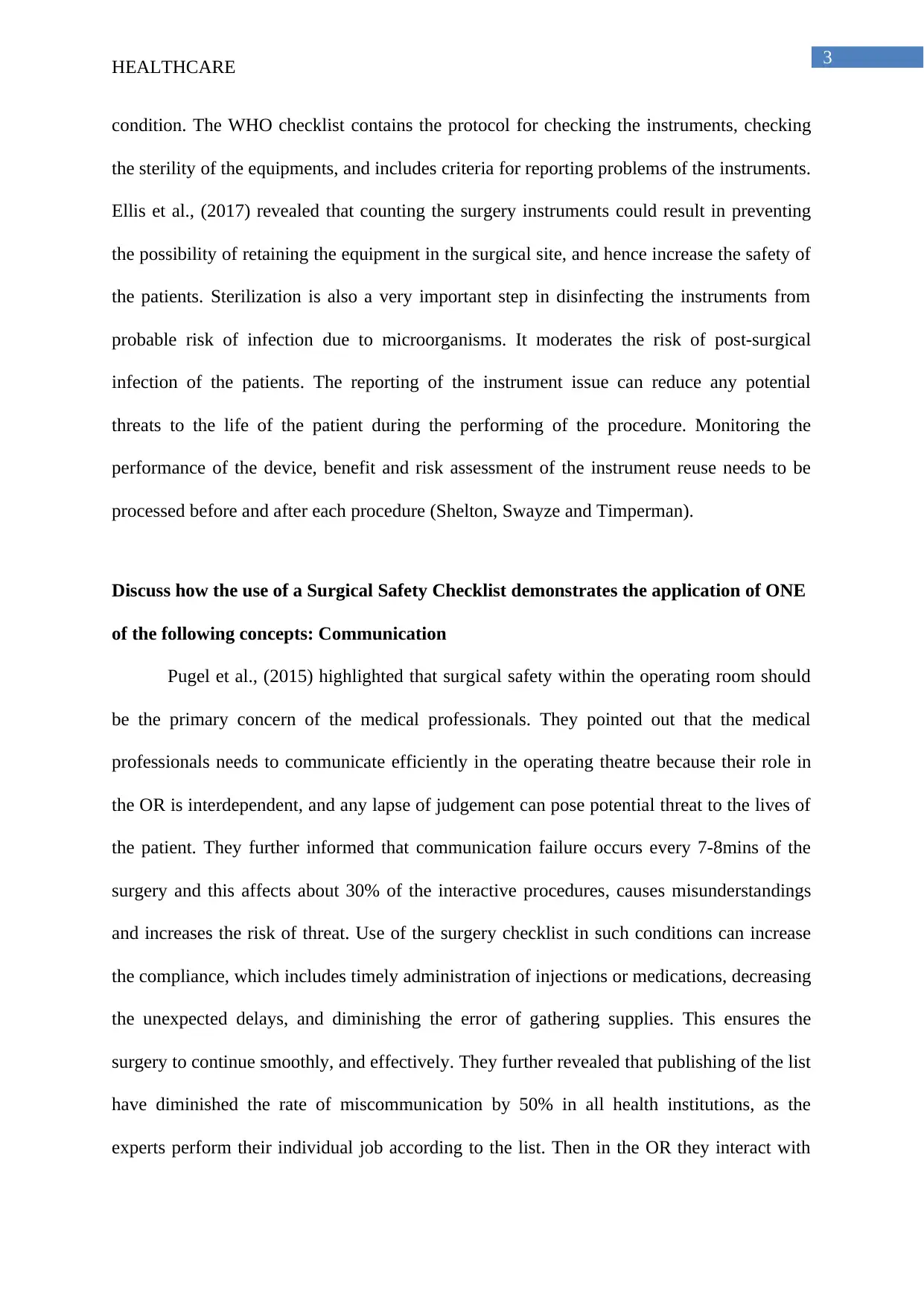
3
HEALTHCARE
condition. The WHO checklist contains the protocol for checking the instruments, checking
the sterility of the equipments, and includes criteria for reporting problems of the instruments.
Ellis et al., (2017) revealed that counting the surgery instruments could result in preventing
the possibility of retaining the equipment in the surgical site, and hence increase the safety of
the patients. Sterilization is also a very important step in disinfecting the instruments from
probable risk of infection due to microorganisms. It moderates the risk of post-surgical
infection of the patients. The reporting of the instrument issue can reduce any potential
threats to the life of the patient during the performing of the procedure. Monitoring the
performance of the device, benefit and risk assessment of the instrument reuse needs to be
processed before and after each procedure (Shelton, Swayze and Timperman).
Discuss how the use of a Surgical Safety Checklist demonstrates the application of ONE
of the following concepts: Communication
Pugel et al., (2015) highlighted that surgical safety within the operating room should
be the primary concern of the medical professionals. They pointed out that the medical
professionals needs to communicate efficiently in the operating theatre because their role in
the OR is interdependent, and any lapse of judgement can pose potential threat to the lives of
the patient. They further informed that communication failure occurs every 7-8mins of the
surgery and this affects about 30% of the interactive procedures, causes misunderstandings
and increases the risk of threat. Use of the surgery checklist in such conditions can increase
the compliance, which includes timely administration of injections or medications, decreasing
the unexpected delays, and diminishing the error of gathering supplies. This ensures the
surgery to continue smoothly, and effectively. They further revealed that publishing of the list
have diminished the rate of miscommunication by 50% in all health institutions, as the
experts perform their individual job according to the list. Then in the OR they interact with
HEALTHCARE
condition. The WHO checklist contains the protocol for checking the instruments, checking
the sterility of the equipments, and includes criteria for reporting problems of the instruments.
Ellis et al., (2017) revealed that counting the surgery instruments could result in preventing
the possibility of retaining the equipment in the surgical site, and hence increase the safety of
the patients. Sterilization is also a very important step in disinfecting the instruments from
probable risk of infection due to microorganisms. It moderates the risk of post-surgical
infection of the patients. The reporting of the instrument issue can reduce any potential
threats to the life of the patient during the performing of the procedure. Monitoring the
performance of the device, benefit and risk assessment of the instrument reuse needs to be
processed before and after each procedure (Shelton, Swayze and Timperman).
Discuss how the use of a Surgical Safety Checklist demonstrates the application of ONE
of the following concepts: Communication
Pugel et al., (2015) highlighted that surgical safety within the operating room should
be the primary concern of the medical professionals. They pointed out that the medical
professionals needs to communicate efficiently in the operating theatre because their role in
the OR is interdependent, and any lapse of judgement can pose potential threat to the lives of
the patient. They further informed that communication failure occurs every 7-8mins of the
surgery and this affects about 30% of the interactive procedures, causes misunderstandings
and increases the risk of threat. Use of the surgery checklist in such conditions can increase
the compliance, which includes timely administration of injections or medications, decreasing
the unexpected delays, and diminishing the error of gathering supplies. This ensures the
surgery to continue smoothly, and effectively. They further revealed that publishing of the list
have diminished the rate of miscommunication by 50% in all health institutions, as the
experts perform their individual job according to the list. Then in the OR they interact with
Secure Best Marks with AI Grader
Need help grading? Try our AI Grader for instant feedback on your assignments.
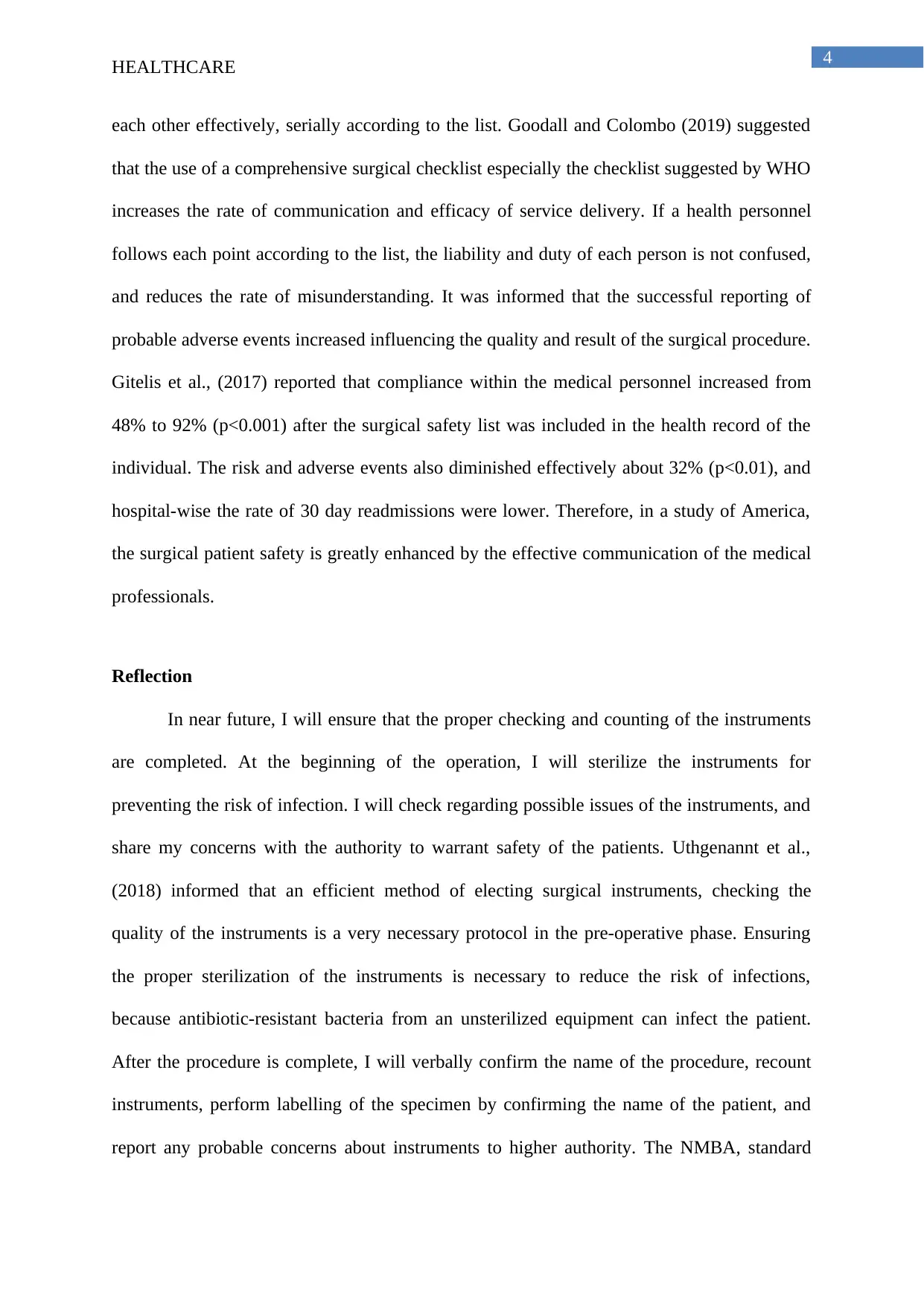
4
HEALTHCARE
each other effectively, serially according to the list. Goodall and Colombo (2019) suggested
that the use of a comprehensive surgical checklist especially the checklist suggested by WHO
increases the rate of communication and efficacy of service delivery. If a health personnel
follows each point according to the list, the liability and duty of each person is not confused,
and reduces the rate of misunderstanding. It was informed that the successful reporting of
probable adverse events increased influencing the quality and result of the surgical procedure.
Gitelis et al., (2017) reported that compliance within the medical personnel increased from
48% to 92% (p<0.001) after the surgical safety list was included in the health record of the
individual. The risk and adverse events also diminished effectively about 32% (p<0.01), and
hospital-wise the rate of 30 day readmissions were lower. Therefore, in a study of America,
the surgical patient safety is greatly enhanced by the effective communication of the medical
professionals.
Reflection
In near future, I will ensure that the proper checking and counting of the instruments
are completed. At the beginning of the operation, I will sterilize the instruments for
preventing the risk of infection. I will check regarding possible issues of the instruments, and
share my concerns with the authority to warrant safety of the patients. Uthgenannt et al.,
(2018) informed that an efficient method of electing surgical instruments, checking the
quality of the instruments is a very necessary protocol in the pre-operative phase. Ensuring
the proper sterilization of the instruments is necessary to reduce the risk of infections,
because antibiotic-resistant bacteria from an unsterilized equipment can infect the patient.
After the procedure is complete, I will verbally confirm the name of the procedure, recount
instruments, perform labelling of the specimen by confirming the name of the patient, and
report any probable concerns about instruments to higher authority. The NMBA, standard
HEALTHCARE
each other effectively, serially according to the list. Goodall and Colombo (2019) suggested
that the use of a comprehensive surgical checklist especially the checklist suggested by WHO
increases the rate of communication and efficacy of service delivery. If a health personnel
follows each point according to the list, the liability and duty of each person is not confused,
and reduces the rate of misunderstanding. It was informed that the successful reporting of
probable adverse events increased influencing the quality and result of the surgical procedure.
Gitelis et al., (2017) reported that compliance within the medical personnel increased from
48% to 92% (p<0.001) after the surgical safety list was included in the health record of the
individual. The risk and adverse events also diminished effectively about 32% (p<0.01), and
hospital-wise the rate of 30 day readmissions were lower. Therefore, in a study of America,
the surgical patient safety is greatly enhanced by the effective communication of the medical
professionals.
Reflection
In near future, I will ensure that the proper checking and counting of the instruments
are completed. At the beginning of the operation, I will sterilize the instruments for
preventing the risk of infection. I will check regarding possible issues of the instruments, and
share my concerns with the authority to warrant safety of the patients. Uthgenannt et al.,
(2018) informed that an efficient method of electing surgical instruments, checking the
quality of the instruments is a very necessary protocol in the pre-operative phase. Ensuring
the proper sterilization of the instruments is necessary to reduce the risk of infections,
because antibiotic-resistant bacteria from an unsterilized equipment can infect the patient.
After the procedure is complete, I will verbally confirm the name of the procedure, recount
instruments, perform labelling of the specimen by confirming the name of the patient, and
report any probable concerns about instruments to higher authority. The NMBA, standard
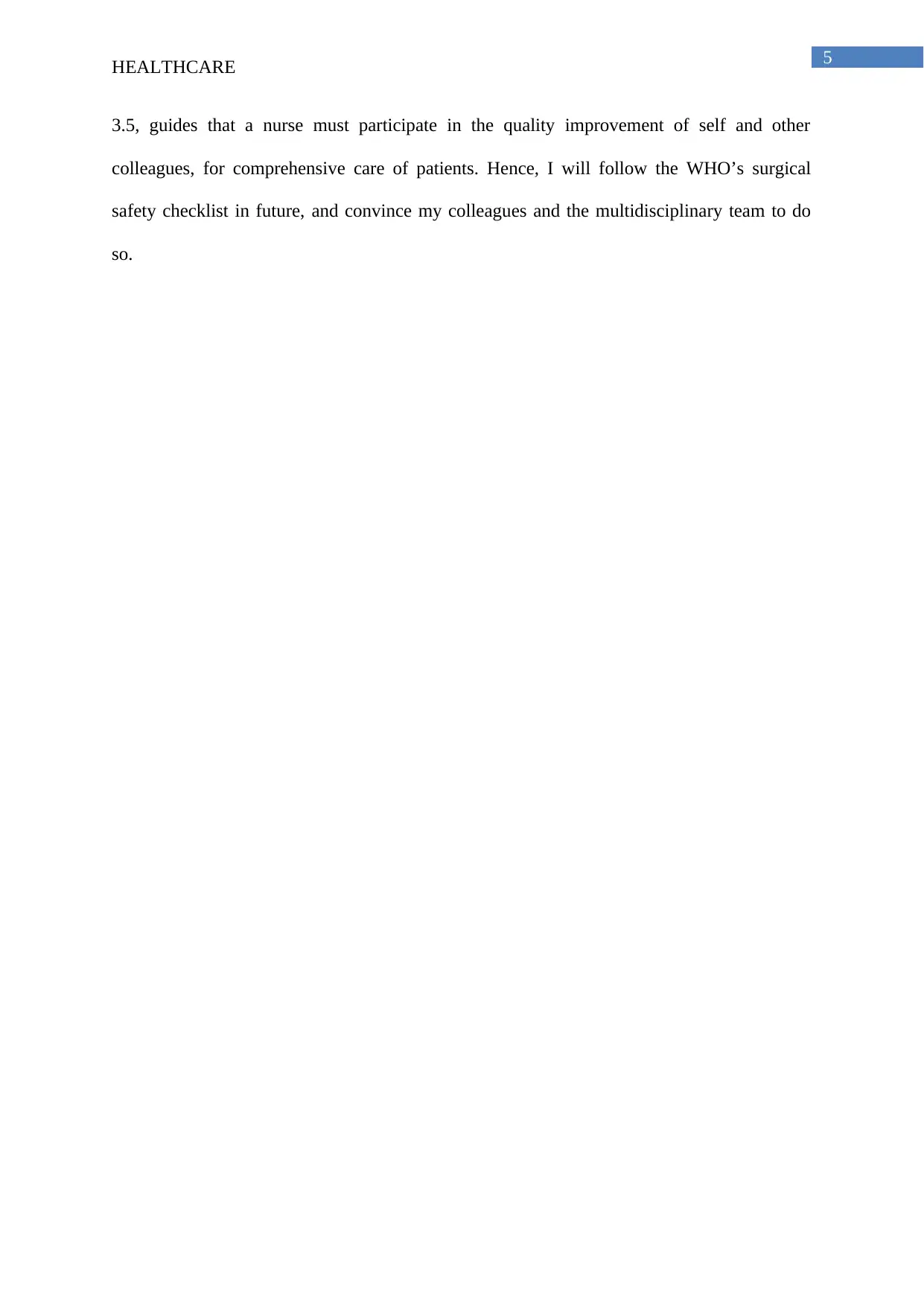
5
HEALTHCARE
3.5, guides that a nurse must participate in the quality improvement of self and other
colleagues, for comprehensive care of patients. Hence, I will follow the WHO’s surgical
safety checklist in future, and convince my colleagues and the multidisciplinary team to do
so.
HEALTHCARE
3.5, guides that a nurse must participate in the quality improvement of self and other
colleagues, for comprehensive care of patients. Hence, I will follow the WHO’s surgical
safety checklist in future, and convince my colleagues and the multidisciplinary team to do
so.
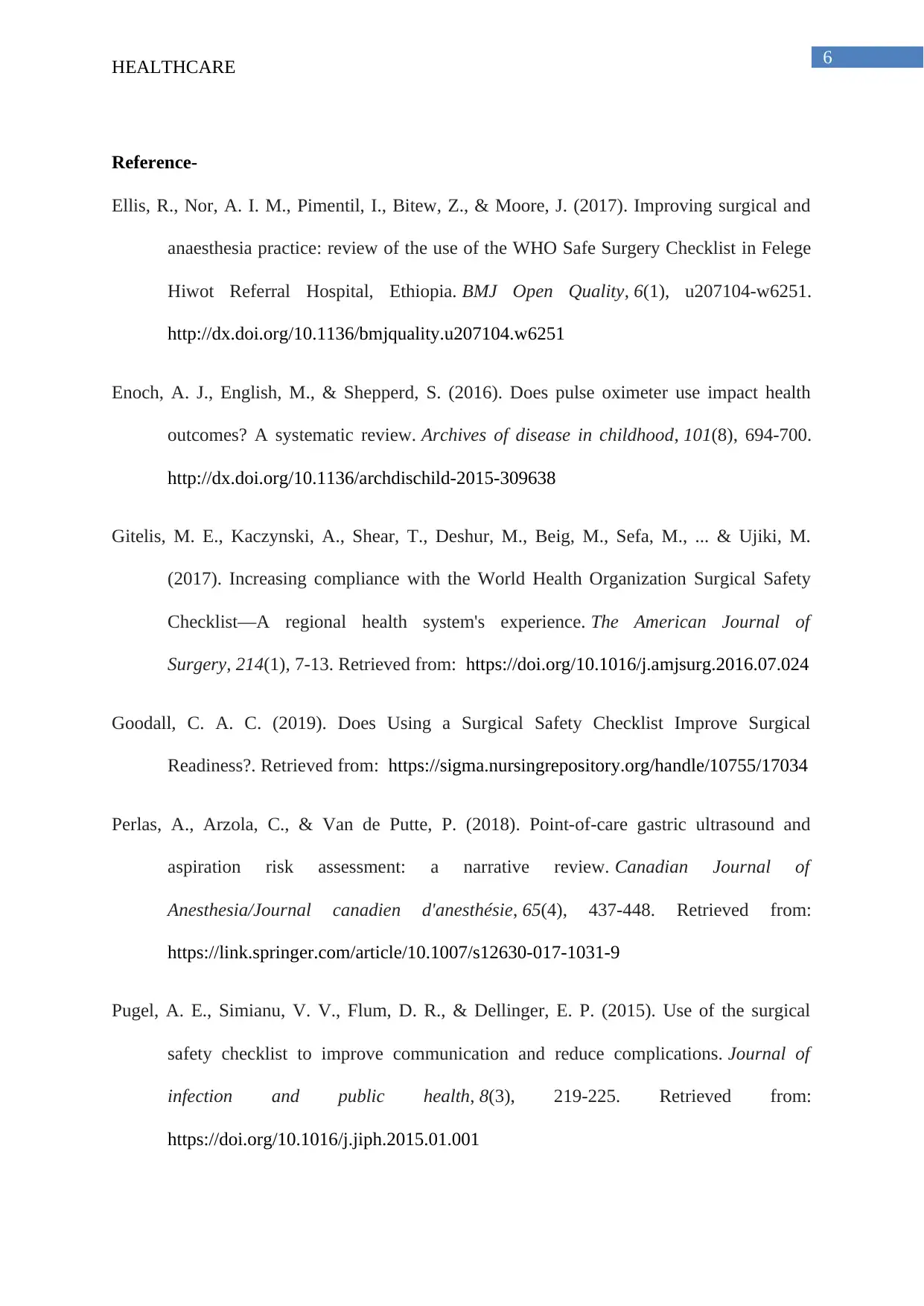
6
HEALTHCARE
Reference-
Ellis, R., Nor, A. I. M., Pimentil, I., Bitew, Z., & Moore, J. (2017). Improving surgical and
anaesthesia practice: review of the use of the WHO Safe Surgery Checklist in Felege
Hiwot Referral Hospital, Ethiopia. BMJ Open Quality, 6(1), u207104-w6251.
http://dx.doi.org/10.1136/bmjquality.u207104.w6251
Enoch, A. J., English, M., & Shepperd, S. (2016). Does pulse oximeter use impact health
outcomes? A systematic review. Archives of disease in childhood, 101(8), 694-700.
http://dx.doi.org/10.1136/archdischild-2015-309638
Gitelis, M. E., Kaczynski, A., Shear, T., Deshur, M., Beig, M., Sefa, M., ... & Ujiki, M.
(2017). Increasing compliance with the World Health Organization Surgical Safety
Checklist—A regional health system's experience. The American Journal of
Surgery, 214(1), 7-13. Retrieved from: https://doi.org/10.1016/j.amjsurg.2016.07.024
Goodall, C. A. C. (2019). Does Using a Surgical Safety Checklist Improve Surgical
Readiness?. Retrieved from: https://sigma.nursingrepository.org/handle/10755/17034
Perlas, A., Arzola, C., & Van de Putte, P. (2018). Point-of-care gastric ultrasound and
aspiration risk assessment: a narrative review. Canadian Journal of
Anesthesia/Journal canadien d'anesthésie, 65(4), 437-448. Retrieved from:
https://link.springer.com/article/10.1007/s12630-017-1031-9
Pugel, A. E., Simianu, V. V., Flum, D. R., & Dellinger, E. P. (2015). Use of the surgical
safety checklist to improve communication and reduce complications. Journal of
infection and public health, 8(3), 219-225. Retrieved from:
https://doi.org/10.1016/j.jiph.2015.01.001
HEALTHCARE
Reference-
Ellis, R., Nor, A. I. M., Pimentil, I., Bitew, Z., & Moore, J. (2017). Improving surgical and
anaesthesia practice: review of the use of the WHO Safe Surgery Checklist in Felege
Hiwot Referral Hospital, Ethiopia. BMJ Open Quality, 6(1), u207104-w6251.
http://dx.doi.org/10.1136/bmjquality.u207104.w6251
Enoch, A. J., English, M., & Shepperd, S. (2016). Does pulse oximeter use impact health
outcomes? A systematic review. Archives of disease in childhood, 101(8), 694-700.
http://dx.doi.org/10.1136/archdischild-2015-309638
Gitelis, M. E., Kaczynski, A., Shear, T., Deshur, M., Beig, M., Sefa, M., ... & Ujiki, M.
(2017). Increasing compliance with the World Health Organization Surgical Safety
Checklist—A regional health system's experience. The American Journal of
Surgery, 214(1), 7-13. Retrieved from: https://doi.org/10.1016/j.amjsurg.2016.07.024
Goodall, C. A. C. (2019). Does Using a Surgical Safety Checklist Improve Surgical
Readiness?. Retrieved from: https://sigma.nursingrepository.org/handle/10755/17034
Perlas, A., Arzola, C., & Van de Putte, P. (2018). Point-of-care gastric ultrasound and
aspiration risk assessment: a narrative review. Canadian Journal of
Anesthesia/Journal canadien d'anesthésie, 65(4), 437-448. Retrieved from:
https://link.springer.com/article/10.1007/s12630-017-1031-9
Pugel, A. E., Simianu, V. V., Flum, D. R., & Dellinger, E. P. (2015). Use of the surgical
safety checklist to improve communication and reduce complications. Journal of
infection and public health, 8(3), 219-225. Retrieved from:
https://doi.org/10.1016/j.jiph.2015.01.001
Paraphrase This Document
Need a fresh take? Get an instant paraphrase of this document with our AI Paraphraser
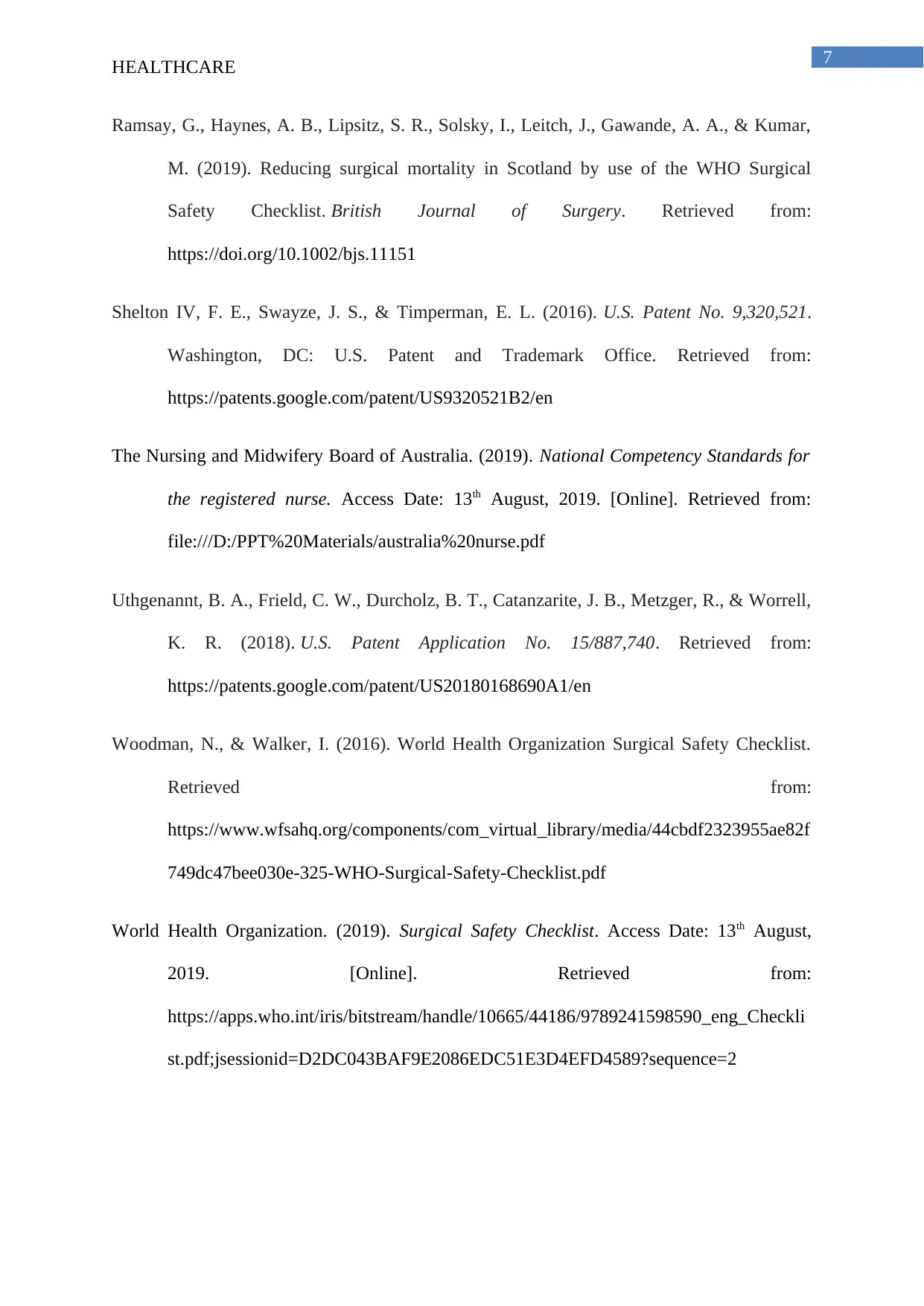
7
HEALTHCARE
Ramsay, G., Haynes, A. B., Lipsitz, S. R., Solsky, I., Leitch, J., Gawande, A. A., & Kumar,
M. (2019). Reducing surgical mortality in Scotland by use of the WHO Surgical
Safety Checklist. British Journal of Surgery. Retrieved from:
https://doi.org/10.1002/bjs.11151
Shelton IV, F. E., Swayze, J. S., & Timperman, E. L. (2016). U.S. Patent No. 9,320,521.
Washington, DC: U.S. Patent and Trademark Office. Retrieved from:
https://patents.google.com/patent/US9320521B2/en
The Nursing and Midwifery Board of Australia. (2019). National Competency Standards for
the registered nurse. Access Date: 13th August, 2019. [Online]. Retrieved from:
file:///D:/PPT%20Materials/australia%20nurse.pdf
Uthgenannt, B. A., Frield, C. W., Durcholz, B. T., Catanzarite, J. B., Metzger, R., & Worrell,
K. R. (2018). U.S. Patent Application No. 15/887,740. Retrieved from:
https://patents.google.com/patent/US20180168690A1/en
Woodman, N., & Walker, I. (2016). World Health Organization Surgical Safety Checklist.
Retrieved from:
https://www.wfsahq.org/components/com_virtual_library/media/44cbdf2323955ae82f
749dc47bee030e-325-WHO-Surgical-Safety-Checklist.pdf
World Health Organization. (2019). Surgical Safety Checklist. Access Date: 13th August,
2019. [Online]. Retrieved from:
https://apps.who.int/iris/bitstream/handle/10665/44186/9789241598590_eng_Checkli
st.pdf;jsessionid=D2DC043BAF9E2086EDC51E3D4EFD4589?sequence=2
HEALTHCARE
Ramsay, G., Haynes, A. B., Lipsitz, S. R., Solsky, I., Leitch, J., Gawande, A. A., & Kumar,
M. (2019). Reducing surgical mortality in Scotland by use of the WHO Surgical
Safety Checklist. British Journal of Surgery. Retrieved from:
https://doi.org/10.1002/bjs.11151
Shelton IV, F. E., Swayze, J. S., & Timperman, E. L. (2016). U.S. Patent No. 9,320,521.
Washington, DC: U.S. Patent and Trademark Office. Retrieved from:
https://patents.google.com/patent/US9320521B2/en
The Nursing and Midwifery Board of Australia. (2019). National Competency Standards for
the registered nurse. Access Date: 13th August, 2019. [Online]. Retrieved from:
file:///D:/PPT%20Materials/australia%20nurse.pdf
Uthgenannt, B. A., Frield, C. W., Durcholz, B. T., Catanzarite, J. B., Metzger, R., & Worrell,
K. R. (2018). U.S. Patent Application No. 15/887,740. Retrieved from:
https://patents.google.com/patent/US20180168690A1/en
Woodman, N., & Walker, I. (2016). World Health Organization Surgical Safety Checklist.
Retrieved from:
https://www.wfsahq.org/components/com_virtual_library/media/44cbdf2323955ae82f
749dc47bee030e-325-WHO-Surgical-Safety-Checklist.pdf
World Health Organization. (2019). Surgical Safety Checklist. Access Date: 13th August,
2019. [Online]. Retrieved from:
https://apps.who.int/iris/bitstream/handle/10665/44186/9789241598590_eng_Checkli
st.pdf;jsessionid=D2DC043BAF9E2086EDC51E3D4EFD4589?sequence=2
1 out of 8
Related Documents
Your All-in-One AI-Powered Toolkit for Academic Success.
+13062052269
info@desklib.com
Available 24*7 on WhatsApp / Email
![[object Object]](/_next/static/media/star-bottom.7253800d.svg)
Unlock your academic potential
© 2024 | Zucol Services PVT LTD | All rights reserved.





